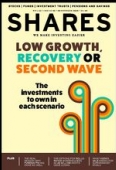Archived article
Please note that tax, investment, pension and ISA rules can change and the information and any views contained in this article may now be inaccurate.
Using the PEG ratio to find growth at a reasonable price

The price-to-earnings (PE) ratio is a great starting point for beginner investors looking to get to grips with the valuation of companies listed on the stock market.
However, it has big limitations. It won’t, for example, give you any idea on the trajectory of a firm’s earnings.
THE PEG RATIO
A measure which takes the PE a step further and looks to incorporate earnings growth is the price-to-earnings growth (PEG) ratio.
This is not much more difficult to calculate than the PE. A stock’s PEG rating is calculated by dividing the PE by the growth rate of its earnings for a one-year period.
As with a PE it is more relevant to look at a forward-looking number, using earnings forecasts.
"Any PEG of 0.5 or less should prompt serious questions and an analysis of the firm’s financial, strategic and operational fundamentals"
Websites like Sharecast and Reuters will have the forecast earnings per share figures for UK stocks which will enable you to work out both the PE, dividing the share price by the forecast earnings per share (EPS), and the level of EPS growth – comparing the forecast number with the most recent reported figure. If earnings are falling the PEG will be a negative number.
As a rule of thumb, a PEG ratio of 1 or lower is considered to demonstrate good value relative to the growth on offer.
The idea of so-called ‘growth at a reasonable price’ (GARP) and the accompanying PEG metric were brought to wider attention by Jim Slater in the early 1990s and explored in depth in his 1992 book The Zulu Principle.
Like the PE, the PEG is just a starting point for further research. It is a tool which might help you narrow down a search for a potential investment, but you need to understand the number in some context.
For example, an engineer might suffer a decline in earnings based on forecasts for the next financial year but is expected to grow earnings by 11% in the following year. The first year PEG is therefore meaningless while in year two its PEG might be a reasonable 0.9. This highlights a problem with PEG in that it is less effective for cyclical or volatile earnings patterns.
Putting PEG into practice
Let’s look at two real-world examples to see how the PEG can add an extra layer of insight.
At a price of £84.94 and forecast EPS of 394.5p, pharmaceutical firm AstraZeneca (AZN) trades on a forward PE of 21.5. Its earnings growth is forecast to be 27%. That means the PEG ratio is 21.5 ÷ 27 = 0.8.
Supermarket Sainsbury’s (SBRY) forecast EPS is 19.5p. At a share price of 192p this translates into a PE of 9.8. Earnings growth is forecast to be 5%. This implies a PEG of 2.
If you simply used the PE you might think Sainsbury’s was much more attractively valued than AstraZeneca but the PEG helps tell you that Sainsbury’s is not cheap compared to its growth profile, based on the principle that bargain stocks must have a PE of 1 or less. Conversely AstraZeneca looks better value using the PEG ratio.
WHAT HAPPENS WHEN EARNINGS COLLAPSE AND RECOVER?
Let’s assume a hypothetical company called Metal Basher had serious operational failures in its factory one year and saw its earnings fall 30% as a result. Having found a fix for the problems, earnings are forecast to rebound by 20% the following year and with the shares on a PE of just 10, this adds up to a PEG of 0.5.
The PE is depressed not just because the shares have adjusted to reflect the lower earnings but because they have also de-rated to a lower valuation to reflect the diminished reliability of said earnings. It might trade on a seemingly attractive PEG but Metal Basher is not really offering growth at a reasonable price.
And adopting the principle that if it looks too good to be true it probably is, any PEG of 0.5 or less should prompt serious questions and an analysis of the firm’s financial, strategic and operational fundamentals.
It is worth examining the earnings trend over a period of time when looking at a PEG, and it is fair to say the metric isn’t as kind to mature companies which generate stable profit and could still have appeal to investors thanks to their ability to pay out dividends.
Also, like the PE, the PEG is reliant on the veracity of earnings forecasts and takes no account of a company’s borrowings. We will look at a measure which incorporates debt in the next part of this series.
Important information:
These articles are provided by Shares magazine which is published by AJ Bell Media, a part of AJ Bell. Shares is not written by AJ Bell.
Shares is provided for your general information and use and is not a personal recommendation to invest. It is not intended to be relied upon by you in making or not making any investment decisions. The investments referred to in these articles will not be suitable for all investors. If in doubt please seek appropriate independent financial advice.
Investors acting on the information in these articles do so at their own risk and AJ Bell Media and its staff do not accept liability for losses suffered by investors as a result of their investment decisions.
Issue contents
Editor's View
Feature
First-time Investor
Great Ideas
- Novacyt still looks really cheap despite share price rally
- Panoply busy signing new contracts and buying businesses
- Premier Foods poised for Hovis windfall
- Don’t miss out on this high-quality European growth company
- Take profits on gold miner Centamin
- Shares in AG Barr start to pick up after reassuring results
Investment Trusts
Money Matters
News
- How Trump’s Covid-19 diagnosis has impacted stock markets
- The options for Rolls-Royce shareholders as £2 billion rights issue looms
- What Asda’s sale means for supermarket rivals
- Cineworld faces liquidity crunch as cinemas close again
- Housebuilders rally on Boris Johnson’s bid to help first-time buyers

 magazine
magazine










